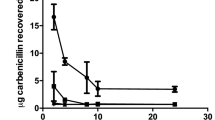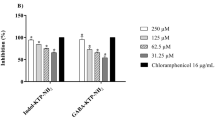Abstract
Diphenyl ditelluride (PhTe)2, an organotelluric compound with pharmacological and toxicological attributes, has shown promise in microorganism studies. Drosophila melanogaster, an alternative animal model, is gaining popularity for novel antimicrobial research due to its cost-effectiveness, versatility, and similarity to vertebrate models. Given the rising antibiotic resistance, particularly in Escherichia coli (E. coli), the exploration of novel antimicrobials is of utmost importance. In (PhTe)2 safety validation, our findings indicate an 50% lethal concentration (LC50) of 41.74 µM for (PhTe)2 following a 48-h exposure period in Drosophila melanogaster. To assess potential motor and neurological deficits, we conducted behavioral analyses employing negative geotaxis and open field tests. Our outcomes reveal alterations in exploratory behavior at concentrations exceeding 50 µM (PhTe)2 in the flies. Consequently, we have established the optimal treatment concentration for Drosophila melanogaster as 10 µM (PhTe)2. Upon safety validation, we gauged the antimicrobial potential of (PhTe)2 through an oral infection model involving axenic flies. After exposing these flies to E. coli for 18–20 h, we treated them with 10 µM of (PhTe)2 for various time spans (0, 3, 6, 12, 24, and 48 h), followed by plating and colony counting. The logarithmic bacterial load curve demonstrated the antimicrobial impact of the compound, highlighting a significant reduction in bacterial load after 3 h of exposure to 10 µM (PhTe)2, with an enhancement of antimicrobial potential lasting up to 48 h. Given these results, we state that 10 µM (PhTe)2 was safe and presented antimicrobial potential, reducing the bacterial load in Drosophila melanogaster.
Graphical Abstract






Similar content being viewed by others
Data Availability
The data that support the findings of this study are available from the corresponding author, upon request.
References
Alkeskas A, Ogrodzki P, Saad M, Masood N, Rhoma NR, Moore K et al (2015) The molecular scherichiation of Escherichia coli K1 isolated from neonatal nasogastric feeding tubes. BMC Infect Dis 15:1–14. https://doi.org/10.1186/s12879-015-1210-7
Araujo SM, de Paula MT, Poetini MR, Meichtry L, Bortolotto VC, Zarzecki MS et al (2015) Effectiveness of γ-oryzanol in reducing neuromotor deficits, dopamine depletion and oxidative stress in a Drosophila melanogaster model of Parkinson’s disease induced by rotenone. Neurotoxicology 51:96–105. https://doi.org/10.1016/j.neuro.2015.09.003
Bonten M, Johnson JR, van den Biggelaar AH, Georgalis L, Geurtsen J, de Palacios PI et al (2021) Epidemiology of Escherichia coli bacteremia: a systematic literature review. Clin Infect Dis 72:1211–1219. https://doi.org/10.1093/cid/ciaa210
Chamilos G, Samonis G, Kontoyiannis D (2011) Drosophila melanogaster as a model host for the study of microbial pathogenicity and the discovery of novel antimicrobial compounds. Curr Pharm Des 17:1246–1253. https://doi.org/10.2174/138161211795703744
Degrandi TH, De Oliveira IM, D’Almeida GS, Garcia CRL, Villela IV, Guecheva TN, Rosa RM, Henriques JAP (2010) Evaluation of the cytotoxicity, genotoxicity and mutagenicity of diphenyl ditelluride in several biological models. Mutagenesis 25:257–269. https://doi.org/10.1093/mutage/geq002
Hirth F (2010) Drosophila melanogaster in the study of human neurodegeneration. CNSNDDT 9:504–523. https://doi.org/10.2174/187152710791556104
Iskandar K, Murugaiyan J, HammoudiHalat D, Hage SE, Chibabhai V, Adukkadukkam S et al (2022) Antibiotic discovery and resistance: the chase and the race. Antibiotics 11:182. https://doi.org/10.3390/antibiotics11020182
Jorge PM, de Oliveira IM, Filippi Chiela EC, Viau CM, Saffi J, Horn F, Rosa RM, Guecheva TN, Pêgas Henriques JA (2015) Diphenyl ditelluride-induced cell cycle arrest and apoptosis: a relation with topoisomerase I inhibition. Basic Clin Pharmacol Toxicol 116:273–280. https://doi.org/10.1111/bcpt.12315
Kavanagh K, Reeves EP (2007) Insect and mammalian innate immune responses are much alike. Microbe 2:596–599. https://doi.org/10.1128/microbe.2.596.1
Kong ASY, Maran S, Yap PSX, Lim SHE, Yang SK, Cheng WH et al (2022) Anti-and Pro-oxidant properties of essential oils against antimicrobial resistance. Antioxidants 11:1819. https://doi.org/10.3390/antiox11091819
Lemaitre B, Hoffmann J (2007) The host defense of Drosophila melanogaster. Annu Rev Immunol 25:697–743. https://doi.org/10.1146/annurev.immunol.25.022106.141615
Luce-Fedrow A, Von Ohlen T, Chapes SK (2009) Ehrlichia chaffeensis infections in Drosophila melanogaster. Infect Immun 77:4815–4826. https://doi.org/10.1128/iai.00594-09
Matharu RK, Charani Z, Ciric L, Illangakoon UE, Edirisinghe M (2018) Antimicrobial activity of tellurium-loaded polymeric fiber meshes. J Appl Polym Sci 135:1–7. https://doi.org/10.1002/app.46368
Murray CJ, Ikuta KS, Sharara F, Swetschinski L, Aguilar GR, Gray A et al (2022) Global burden of bacterial antimicrobial resistance in 2019: a systematic analysis. Lancet 399:629–655. https://doi.org/10.1016/S0140-6736(21)02724-0
Nash JH, Villegas A, Kropinski AM, Aguilar-Valenzuela R, Konczy P, Mascarenhas M et al (2010) Genome sequence of adherent-invasive Escherichia coli and comparative genomic analysis with other E. coli pathotypes. BMC Genomics 11:1–15. https://doi.org/10.1186/1471-2164-11-667
Pinheiro FC, Bortolotto VC, Araujo SM, Couto SF, Dahleh MMM, Cancela M et al (2022) Oxidative stress response system in Escherichia coli arising from diphenyl ditelluride (PhTe) 2 exposure. Toxicol in Vitro 83:105404. https://doi.org/10.1016/j.tiv.2022.105404
Ponnusamy D, Kozlova EV, Sha J, Erova TE, Azar SR, Fitts EC et al (2016) Cross-talk among flesh-eating Aeromonas hydrophila strains in mixed infection leading to necrotizing fasciitis. Proc Natl Acad Sci 113:722–727. https://doi.org/10.1073/pnas.1523817113
Puntel RL, Roos DH, Seeger RL, Rocha JBT (2013) Mitochondrial electron transfer chain complexes inhibition by different organochalcogens. Toxicol Vitr 27:59–70. https://doi.org/10.1016/j.tiv.2012.10.011
Robert A, Talagrand-Reboul E, Figueras MJ, Ruimy R, Boyer L, Lamy B (2023) Drosophila melanogaster systemic infection model to study altered virulence during polymicrobial infection by aeromonas. Pathogens 12:405. https://doi.org/10.3390/pathogens12030405
Romeo Y, Lemaitre B (2008) Drosophila immunity: methods for monitoring the activity of Toll and Imd signaling pathways. Innate Immun. https://doi.org/10.1007/978-1-59745-570-1_22
Serwecińska L (2020) Antimicrobials and antibiotic-resistant bacteria: a risk to the environment and to public health. Water 12:3313. https://doi.org/10.3390/w12123313
Siva-Jothy JA, Prakash A, Vasanthakrishnan RB, Monteith KM, Vale PF (2018) Oral bacterial infection and shedding in Drosophila melanogaster. JoVE 135:e57676. https://doi.org/10.3791/57676
Tanji T, Hu X, Weber AN, Ip YT (2007) Toll and IMD pathways synergistically activate an innate immune response in Drosophila melanogaster. Mol Cell Biol 27:4578–4588. https://doi.org/10.1128/mcb.01814-06
Trindade C, Juchem ALM, Guecheva TN, De Oliveira IM, Dos Santos Silveira P, Vargas JE, Puga R, Pessoa C, Henriques JAP (2019) Diphenyl ditelluride: redox-modulating and antiproliferative properties. Oxid Med Cell Longev. https://doi.org/10.1155/2019/2510936
Tracy C, Krämer H (2017) Escherichia coli infection of Drosophila. Bio-Protoc 7:e2256–e2256. https://doi.org/10.21769/bioprotoc.2256
Van den Bergh B (2022) Bugs on drugs: a drosophila melanogaster gut model to study in vivo antibiotic tolerance of E. coli. Microorganisms 10:119. https://doi.org/10.3390/microorganisms10010119
Wang M, Tang JC (2010) Research of antibiotics pollution in soil environments and its ecological toxicity. J Agro Environ Sci 29:261–266
Yu S, Luo F, Xu Y, Zhang Y, ** LH (2022) Drosophila innate immunity involves multiple signaling pathways and coordinated communication between different tissues. Front Immunol 13:905370. https://doi.org/10.3389/fimmu.2022.905370
Funding
The authors are grateful for the financial support received from the Conselho Nacional de Desenvolvimento Científico e Tecnológico (CNPq) (308120/2020-5), the Fundação de Amparo à Pesquisa do Estado do Rio Grande do Sul (FAPERGS) (PQG 19/2551-0001913-0; 19/2551-0001975-0), and the Coordenação de Aperfeiçoamento de Pessoal de Nível Superior (CAPES)—Financial Code 001 for the support and research grants provided.
Author information
Authors and Affiliations
Contributions
FCB and MP designed the study. JSSN and GZ compound synthesis. FCB, VCB, SMA and MMMD conducted the safety validation and behavioral tests. FCB, VCB, SMA and MMMD analyzed the data and drafted the manuscript. AA and MP provided the main resources. SMA, MMMD and MP revised the manuscript. All authors contributed substantially to the study and approved the final version of the manuscript.
Corresponding author
Ethics declarations
Conflict of interest
The authors declare that they have no conflict of interest.
Additional information
Publisher's Note
Springer Nature remains neutral with regard to jurisdictional claims in published maps and institutional affiliations.
Rights and permissions
Springer Nature or its licensor (e.g. a society or other partner) holds exclusive rights to this article under a publishing agreement with the author(s) or other rightsholder(s); author self-archiving of the accepted manuscript version of this article is solely governed by the terms of such publishing agreement and applicable law.
About this article
Cite this article
Pinheiro, F.C., Bortolotto, V.C., Araujo, S.M. et al. Antimicrobial Effect of Diphenyl Ditelluride (PhTe)2 in a Model of Infection by Escherichia coli in Drosophila melanogaster. Indian J Microbiol (2024). https://doi.org/10.1007/s12088-024-01196-8
Received:
Accepted:
Published:
DOI: https://doi.org/10.1007/s12088-024-01196-8




